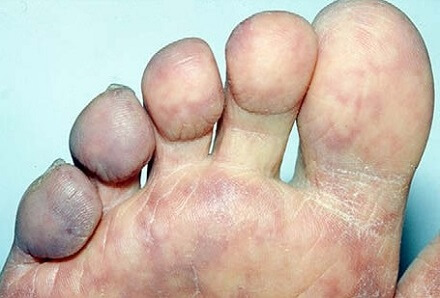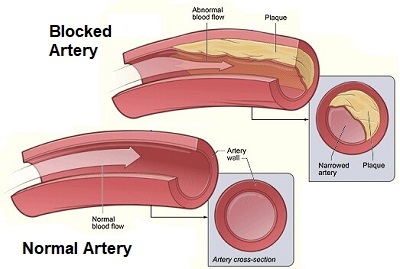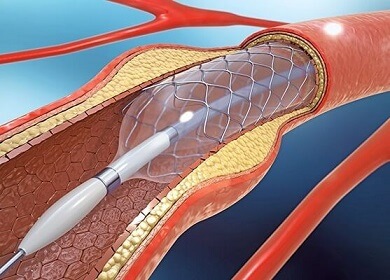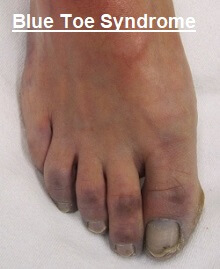- Home
- Diagnosis Guide
- Toe Pain
- Blue Toe Syndrome
Blue Toe Syndrome
Written By: Chloe Wilson BSc(Hons) Physiotherapy
Reviewed By: FPE Medical Review Board

Blue toe syndrome is caused by a blockage of the small blood vessels in the foot that reduces the flow of blood and oxygen to the tissues.
It usually develops due to a problem higher up the blood stream such as an aneurysm or atherosclerosis.
Blue toe syndrome, aka Trash Foot or Purple Toe Syndrome, develops suddenly and can be really painful. It may affect just one toe or a number of toes.
The toes turn a blue colour due to the lack of oxygen and if left untreated the skin can ulcerate, tissues begin to die and eventually gangrene sets in. If this happens, amputation may be necessary so early treatment is essential.
Here we will look at the common symptoms, causes, diagnosis and treatment options for blue toe syndrome. For other causes of toe pain, visit the toe pain diagnosis section.
Symptoms of Blue Toe Syndrome
The most common symptoms of Blue Toe Syndrome are:
- Intense Pain: High levels of pain. This tends to be in the foot and can sometimes also occur further up the leg
- Livedo Reticuarlis: this is a lace-like bluey purplish discoloration of the skin
- Foot Pulses: The peripheral foot pulses are usually still palpable
- Age: The syndrome usually affects people over the age of fifty
Trash Foot symptoms usually develop suddenly and rapidly. They may affect one or more toes but ar usually confined to one foot.
Causes Of Purple Toe Syndrome
Blue or purple toe syndrome develops when there is a blockage in the small blood vessels of the foot. This blockage reduces the blood flow to the toes, known as ischaemia. The blockage is usually caused by either cholesterol crystals or a lump of plaque getting stuck.

Plaque deposits are a waxy substance made up of things like fatty acids, cholesterol and calcium. They build up on the inner lining of arterial walls over a number of years.
Sometimes, small bits of plaque break off, known as embolisation, and then travel round the body in the blood stream.
In blue toe syndrome, the plaque tends to break off from blood vessels near the groin and abdomen (known as the abdominal aorta-iliac-femoral arterial system). It travels through the blood stream and gets lodged in the small blood vessels of the foot.
This limits the flow of oxygen and glucose to the toes, both of which are needed to keep cells alive. The result is destruction and death of the surrounding tissues. The toes start to turn a bluey purple colour (known as cyanosis) due to the lack of oxygen, hence the name blue toe syndrome.
Trash foot is most common in men over the age of 40. Embolization and resultant blockage of the blood vessels can occur for a number of reasons:
- Spontaneously: a piece of plaque breaks off with no specific cause
- Surgical Procedure: most commonly vascular surgery or angiography (where a small catheter is passed through the blood vessels to examine the arteries)
- Medical Treatment: Anti-coagulants (blood thinners such as warfarin) or thrombolytic treatment (to break up large blood clots)
Diagnosing Trash Foot
Ultrasound scans and CT angiograms are the diagnostic tools of choice with purple toe syndrome.
Blue toe syndrome can be difficult to diagnosis. Usually, the most common sign of a blockage in the blood vessels is the loss of foot pulses but with purple toe syndrome, the foot pulses are usually unaffected.
Diagnosis of Blue Toe Syndrome also concentrates on finding the source of the problem i.e. where the embolus blockage came from in the first place.
Usually there will be a problem further up the arterial tree in one of the proximal blood vessels such as an aneurysm (balloon-like bulge filled with blood in the wall of a blood vessel) or plaque deposits (known as atherosclerosis).
Other conditions that can present in a similar way to blue toe syndrome include Raynaud's disease, blood clotting disorders, arterial insufficiency, Buerger's disease, and peripheral neuropathy. All of these conditions cause reduced blood supply to the feet and can lead to discoloration, numbness, and pain.
How Do You Treat Blue Toe Syndrome?
Once the underlying cause of blue foot syndrome has been found, it can be treated by:

- Stenting: this is where a mesh tube is inserted into the affected blood vessel to hold it open and prevent restriction of blood flow
- Bypass Surgery: where blood flow is diverted around major arteries that are narrow or partially blocked. A healthy blood vessel is taken from another part of the body and attached above and below the affected area so that the blood flow diverts around the blockage
- Anti-coagulants and Anti-Platelet Therapy: These can help in the short time but are associated with a high recurrence rate of blue toe syndrome
Blue Toe Syndrome Recovery
Recovery from blue toe syndrome typically takes several weeks to months, depending on the severity of the condition. It helps to avoid activities that may lead to further injury such as heavy lifting, running, or jumping, to wear supportive footwear, and to take pain medications as needed.
If blue toe syndrome is left untreated, gangrene can set it. Gangrene is a serious condition where a lack of blood supply causes the tissue to die. Early treatment involves debridement (surgical removal of the dead tissue) and antibiotics to treat infection. If allowed to progress, amputation of the affected body part may be required.
Your Questions Answered
Is Blue Toe Syndrome An Emergency? Blue toes on their own are not a medical emergency, but if you have the classic symptoms of Blue Toe Syndrome e.g. your toes turn blue suddenly for no obvious reason and are extremely painful, there is a good chance the blood flow to the foot may be affected which would require immediate medical attention.
Is Blue Toe Syndrome Dangerous? If the blood flow to the foot is reduced, then tissues can quickly begin to die and gangrene can set in. If blue toe syndrome is left untreated long term, amputation of the toes or foot may be required so prompt treatment is essential.
What Can Cause Blue Toes? Anything which affects the blood flow to the feet can cause discoloration of the toes due to an insufficient supply of blood and oxygen to the tissues. This is known as peripheral cyanosis.
What Else Could It Be?
Trash foot is not the only cause of pain and discoloration of the skin. Another common cause is Raynaud’s Disease, a condition where the blood vessels spasm, limiting flow to the fingers and toes. Treatment here is usually with medication, avoiding the cold by wearing gloves and relaxation techniques
If blue toe syndrome is not sounding quite like your problem, visit the toe pain diagnosis section for help working out what may be causing your pain.
You may also be interested in the following articles:
- Pain On Top Of Foot
- Foot Arch Pain
- Nerve Pain In The Foot
- Foot Rashes
- Foot Numbness
- Burning Foot Pain
- Foot Lumps & Bumps
Related Articles
Page Last Updated: 11/01/23
Next Review Due: 11/01/25







